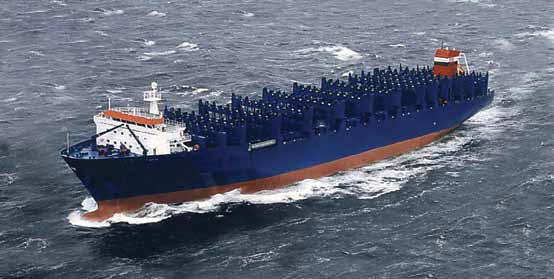
- •Sea Practice Report
- •6.Deck Cadet Duties
- •7.Duties of an oow
- •8.Boat Safety Drills
- •1.Port Description
- •2. Bridge Equipment
- •3 . Cargo operations
- •4. Shipping Documents
- •5. Watchstanding
- •6.Deck Cadet Duties
- •Maintenance and Safety
- •Navigation
- •Port Work
- •Nautical Preparations
- •Records
- •7.Duties of an oow
- •Navigation
- •Watchkeeping
- •Operations of the Ship
- •Emergency Response
- •8.Boat Safety Drills
- •Abandon Ship
- •Man Overboard
- •9. Imo Standard Marine Communication Phrases
- •10. Ship Correspondence
3 . Cargo operations
1: The containers are brought to the ships side by truck or are stowed directly on the quayside. The container gantry crane attaches to the container and lifts it off the truck. The truck drives away. The container is maintained at the truck flat bed height for step 2 below.
2: Depending on the ship configuration and if the container will be secured above or below the hatch cover the stevedores (1 on each end of the container) take the proper container fitting out of the twistlock bins inside the pinboxand attach them to the container corners.
For above deck stowage:
No fitting needed (For the first layer above deck some ships keep the twistlock permanently in the container foundation)
No fitting needed (if cell guides are used above deck)
Fully Automatic Twistlocks (automatic lock and unlock)
Semi-Automatic Twistlocks (automatic lock and manual unlock)
Midlocks (if two 20 foot containers are stowed in a 40 foot slot then midlocks are used where the containers meet)
For below deck stowage:
No fitting needed (if cell guides are used below deck)
Hanging Stackers (non locking - they hang from the upper container in the stack)
3: After the Stevedores have placed the fittings in the container corners (if needed) the crane moves the container to the correct position on the ship. The container is lowered and released. If an automatic or semi-automatic twistlock is used in the container corners the weight of the container locks the fittings at the container corners onto the container below.
T his
photo shows a container ship that uses no hatch covers. The cell
guides run from the tank tops at the bottom of the ship to the
maximum container height. On a ship like this the containers can be
loaded without fittings directly into the cell guides. Cell guides
are metal structures that keep the containers in place without any
other equipment being needed such as twistlocks, lashing bars or
turnbuckles thus making loading and unloading faster and less costly.
his
photo shows a container ship that uses no hatch covers. The cell
guides run from the tank tops at the bottom of the ship to the
maximum container height. On a ship like this the containers can be
loaded without fittings directly into the cell guides. Cell guides
are metal structures that keep the containers in place without any
other equipment being needed such as twistlocks, lashing bars or
turnbuckles thus making loading and unloading faster and less costly.
The disadvantage of a ship such as this is that cell guides inhibit the ships flexibility in that it cannot take a variety of container sizes and in addition the number of overall containers is reduced due to the stack weights (the number of containers in a stack are limited by overall weight).
4: For below deck (below the hatch covers) stowage no additional securing is needed. The hatch covers are put in place and then containers can be loaded on top of the hatch cover. If the hatch covers are removed then containers can be stowed below deck.
5: For above hatch cover container stowage after the containers are set in place and the twistlocks are locked (automatically for semi-automatic and fully automatic twistlocks) lashing bars and turnbuckles must be attached and tightened. There is a cross pattern for every box from deck to bottom of 2nd tier along the complete row. There is an additional pattern of lashing from the bottom of the 3rd tier to the deck on the end container stack and possibly the 2nd to end container stack. In some cases vertical lashing bars are used.
6: Once the ship is loaded and the container lashing secured by the Stevedore team the ship can depart port.
7: The process is reversed for unloading.
There are several rules and tips for loading container ships:
1 )
Minimize the number of crane moves. Algorithms
and computer systems help plan the most efficient and practical
storage schemes so ships can get in and out of port fast.
)
Minimize the number of crane moves. Algorithms
and computer systems help plan the most efficient and practical
storage schemes so ships can get in and out of port fast.
2) Cold boxes need juice. Refrigerated containers—or “reefers”—must be placed near a power source.
3) Guard your vessel. Containers are sealed after inspection, but thieves can use simple tools to get around the seals and pop open the doors.
4) Heaviest boxes go down low. This prevents the stack from collapsing. And they’re distributed as evenly as possible to keep the ship balanced.
5) Place flammable stuff away from the edges. If a ship will be traveling through, say, the Indian Ocean, containers of combustible material could be ignited by rocket-propelled grenades from attacking pirates.
6) Every box has an ID number. It shows the owner (green) and category (yellow) of the container, followed by a serial number (blue) and check digit (red). Once they’re loaded, a separate system locates each container by bay, row, and tier.
7) Keep certain chemicals apart. Acetylene must be separated by at least one container space or bulkhead from chlorine; barium cyanide must be isolated from acids.
